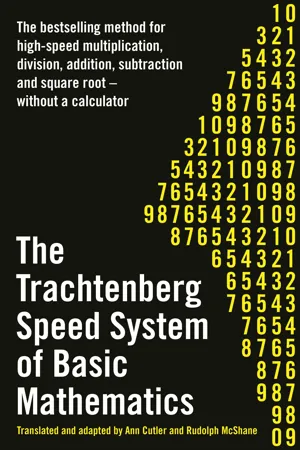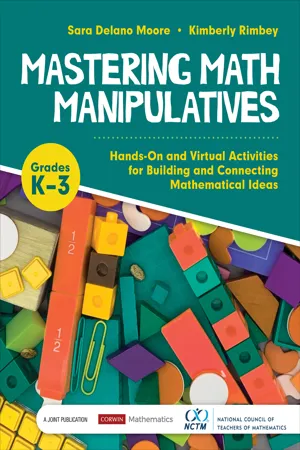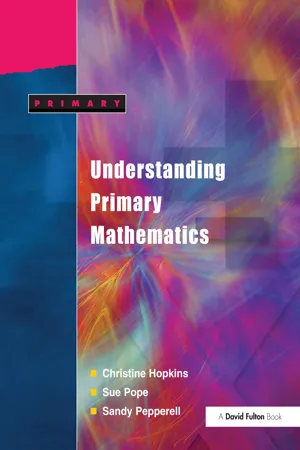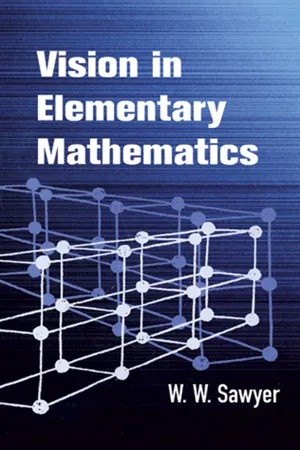Mathematics
Squares
In mathematics, a square is a quadrilateral with four equal sides and four right angles. The area of a square is calculated by squaring the length of one of its sides. The perimeter of a square is found by multiplying the length of one side by 4.
Written by Perlego with AI-assistance
Related key terms
5 Key excerpts on "Squares"
- Jakow Trachtenberg, Ann Cutler, Rudolph McShane(Authors)
- 2011(Publication Date)
- Souvenir Press(Publisher)
CHAPTER SIXSquares and square rootsINTRODUCTIONHere are diagrams of three ranches out west. They must be in Texas, because each one is several miles long on each side. They happen to be perfectly square in shape because these are fictitious ranches and we can make them square if we wish:What are their areas? The first has an area of 9 square miles. This is because each side is 3 miles, and 3 times 3 is 9. In the same way the area of the second is 16 square miles, and the area of the third is 36 square miles.Notice the arithmetic involved here. In each case it consists of multiplying a number by itself. This action is called “squaring” the number. Squaring 3 we have 9. This mathematical operation comes up as part of various problems. The simplest and most natural way in which it comes up is just what we had here, the question of finding the area of a square. For that reason it is natural for everyone to speak of it as squaring the number and to call the result of doing so the square of the number. For instance:So we see that squaring defines a mathematical “operation.” The idea of an operation is this: we operate on a number when we change it to another number. Many simple examples are familiar to everyone–for instance, doubling. We double 12, and it becomes 24. The simplest operation of all is probably that indicated by the instruction “increase by one.” We operate in this way on 12, and it becomes 13, and so on. In each case we start with a particular number, in fact any number we wish to talk about, and we end up at a different number. We move from one number to another one.Suppose we take the result of doubling, like the 24 that we mentioned, and we apply a new operation, “halving.” We take half of 24 and we are back at 12, where we started. Doubling and halving are opposite operations, in that sense. We say that halving is the “inverse” operation to doubling. What is the operation inverse to “increase by one?” Obviously, “decrease by one.” Apply this to the 13 of the last paragraph, and we are back at 12 again.- eBook - ePub
Mastering Math Manipulatives, Grades K-3
Hands-On and Virtual Activities for Building and Connecting Mathematical Ideas
- Sara Delano Moore, Kimberly Ann Rimbey(Authors)
- 2021(Publication Date)
- Corwin(Publisher)
In this activity, students use the Make a Sketch and Create a Diagram strategies to connect the concrete representations created with the unit Squares to visual and symbolic representations in the table. Students should verbalize that the areas represent the number of unit Squares in each figure, while the perimeters represent the linear distance around the outside of each figure. By recording their work in a table, they might be able to begin making generalizations about the relationship between area and perimeter when the area remains the same but the configuration of the square units changes.Notes
Closing Reflection: Unit Squares
How do I use unit Squares in my classroom now? What concepts do I use them to teach? What new ways have I found to use unit Squares to better support student understanding? What are my goals to make unit Squares a more regular part of my instruction?Descriptions of Images and Figures
Back to image The details of the unit Squares and the three figures formed using them are as follows:Three red and two yellow Squares are combined to form the figure of a table; a green square, a red square, a yellow square, and two blue Squares are combined to form the figure of 5 on dice; five green Squares are combined to form a plus symbol.Back to imageThe description below the Squares reads: It took 15 Squares to cover the rectangle. I can add or multiply to get to 15. 5 plus 5 plus 5 equals 15; 3 plus 3 plus 3 plus 3 plus 3 equals 15; 3 times 5 equals 15; 5 times 3 equals 15.Back to image The details of the equations represented by the unit Squares are as follows:- Eight green Squares on the left represent the equations 4 times 2 equals 8
- Four yellow Squares on the right represent the equation 2 times 2 equals 4.
- Both green and yellow Squares together represent the equation 8 plus 4 equals 12.
Back to image The details of three sets of unit square and the respective equations are as follows: In the first set, each row has five blue Squares and a yellow square. This set represents the equation: 3 times 5 and 3 times 1 equals 15 plus 3 equals 18. - eBook - ePub
- Christine Hopkins, Ann Pope, Sandy Pepperell(Authors)
- 2013(Publication Date)
- David Fulton Publishers(Publisher)
A History of Mathematics: an introduction Harlow: Addison-Wesley.Kline, M. 1972 Mathematics in Western Culture Harmondsworth: Penguin.Royal Society/JMC 2001 Teaching and Learning Geometry 11–19 London: Royal Society.4.2 PROPERTIES OF SHAPE
Much of the power of mathematics comes from making statements that are true for a whole set of objects such as all even numbers or all quadrilaterals. An important stage in the process is agreeing on useful ways of classifying types of shapes and types of numbers.Consider the shapes below: these are plane shapes.They could be sorted into:They could also be sorted into:POLYGONS
The closed shapes that have only straight edges are known as polygons. ‘Poly’ means many and ‘gons’ means knees or angles. One way of classifying polygons is by the number of sides they have:When there are more than twelve sides the polygon can be named informally, for example a polygon with 15 sides can be referred to as a 15-gon. There are many ways of sorting polygons:All the concave shapes have at least one of their interior angles greater than 180°. Polygons with all interior angles less than 180° are convex.Two regular polygons have special names: a regular triangle has three equal sides and three equal angles, it is called an equilateral triangle a regular quadrilateral has four equal sides and four equal angles, it is called a square.PROPERTIES
The properties of any geometric shape are those features which remain invariant for that shape. For example a triangle always has three sides and the sum of the interior angles is 180°. The lengths of the sides and the sizes of the interior angles can vary.TRIANGLES
Triangles, with just three sides, are the simplest polygons, they can be classified: either by the size of the largest angleor by the lenghts of their sideAn equilateral triangle is an example of a regular polygon.Two shapes which may differ in size but are otherwise identical are called similar.E.g. all equilateral triangles are similar. All isosceles right-angled triangles are similar. - eBook - ePub
- Sandra Rush(Author)
- 2017(Publication Date)
- Research & Education Association(Publisher)
p = 5 + 15 + 5 + 15 = 40. Answer choices (A) and (B) are the lengths of the sides, and answer choice (C) didn’t double the sides to find the perimeter.Square
Now we come to the most restrictive, but also the most popular, quadrilateral—the square. A square is a parallelogram with four equal angles and four equal sides. It can also be thought of as a rhombus with four equal angles or a rectangle with four equal sides.Therefore, the square has all of the properties of the parallelograms mentioned above, as shown in the following table.Properties of the SquareSince a square is a rectangle with equal sides, its perimeter is and its area isProperty of the square: Same as property for: Opposite sides are parallel Parallelogram All sides are equal Rhombus All angles are equal Rectangle Diagonals bisect each other Parallelogram Diagonals are perpendicular to each other Rhombus Diagonals have equal lengths Rectangle Example 6.10.The value of x in the quadrilateral below isA. 55° B. 110° C. 50° D. cannot be determined because they cannot be equal(A) 55°. All of the angles in a quadrilateral total 360°. So we haveAnswer 6.10.The problem is to find the value of x, not 2x. Also, unless you are told what a figure is, don’t assume it is what looks like it is. This figure looks like a trapezoid, but it isn’t. Answer choice (D) is true for a trapezoid, but not this figure, which is just a quadrilateral, as the problem states.Which of the following characteristics of a square is enough to prove that a quadrilateral is a square and not just a parallelogram, rectangle, or rhombus? A. All of the sides are equal. B. The opposite sides are parallel to each other. C. The adjacent sides are perpendicular to each other. D. The diagonals are equal and perpendicular bisectors of each other.Example 6.11.Answer 6.11.(D). Only a square has all three - eBook - ePub
- W. W. Sawyer(Author)
- 2012(Publication Date)
- Dover Publications(Publisher)
2 . But time and again children seem to relapse into giving the distance round when the area is asked for. It seems necessary to emphasize this distinction, perhaps by having children actually pasting square pieces of paper over the region for which the area has been asked. Every time the word or the idea of area is involved, it is well to make some reference to pasting paper Squares or to covering a floor, or to some similar illustration that will make clear which concept we have in mind. Anyone without classroom experience may be surprised how long it takes some children (including clever ones) to fix this distinction.In the square 3 feet by 3 feet we see, of course, 3 rows of 3 Squares each, so we have once more a picture of 3 × 3. If the square had sides 7 feet long, it would contain 7 × 7 Squares.The argument can also be made to work in the opposite direction. If a square can be covered by 9 black Squares, it must be 3 feet by 3 feet. There is no other way of arranging 9 black Squares so that they exactly cover a larger square. If 25 black Squares exactly cover a larger square, that squarc must be of side 5 feet, for 5 x 5 = 25, and no other number will do.Now we are ready to begin.THE TILTED SQUARE
Suppose we have a square, ABCD (see Figure 55 ), each side of which is 7 feet long. We mark points P, Q, R, S on the sides of this square. P is 3 feet from A , Q is 3 feet from B, and so on, as shown in the figure. The distance from P to B, of course, is 4 feet, since the side of the square is 7 feet.The picture we have drawn has a certain amount of symmetry. If we were to rotate it, so that A came to where B is now, B to where C is now, and so on, the appearance of the figure (apart from the lettering) would be unchanged.What shape do the children think PQRS is? The general opinion seems to be that it is a square. We accept this verdict.We now imagine that we have 49 square pieces of linoleum, each 1 foot by 1 foot. These would be just enough to cover the whole square ABCD. How many of them would be required to cover the tilted square, PQRS?
Index pages curate the most relevant extracts from our library of academic textbooks. They’ve been created using an in-house natural language model (NLM), each adding context and meaning to key research topics.




